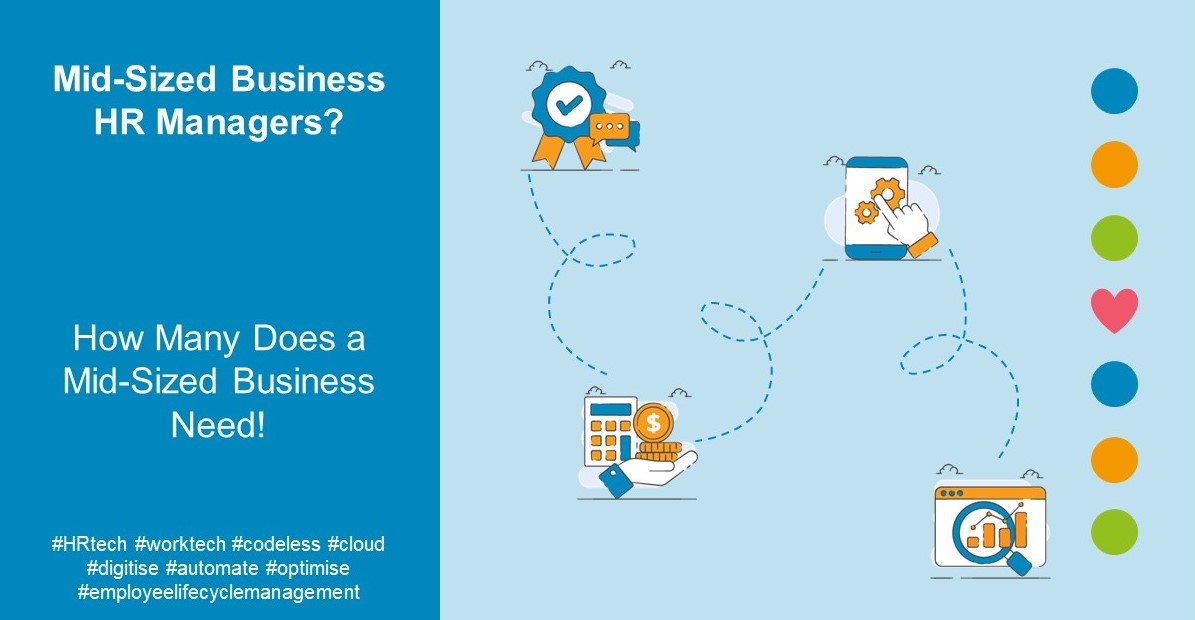As a business owner or manager, you might be wondering how many HR managers your company needs, and when the right time is to start building an HR department.
With the increasing demand for effective HR practices, it is essential for small to mid-sized businesses to understand the best HR strategies for their specific needs.
In this post, we’ll be finding out how many HR managers your business needs, as well as:
-
The HR-to-employee ratio
-
The duties of an HR manager
-
The human resources requirements for your business
-
What to consider when thinking about your HR manager (company size, the complexity of HR tasks, company culture and employee relations, legal compliance and risk management, and HR outsourcing as an alternative)
-
The benefits of having an HR manager, like improved employee management and productivity, mitigation of legal risks and compliance issues, attraction and retention of top talent, and increased efficiency and cost savings.
By the end of this article, you’ll have a complete understanding of the HR requirements for your business. Let’s get to it! 🚀
What to Consider When Thinking About HR for Mid-Sized Businesses
The primary responsibility of human resources managers and their teams is to plan and implement strategies that align with the company's goals through its employees. But when it comes to thinking about HR for your mid-sized business, there are several important factors to consider. ⬇️

Company size
The size of your company and the number of employees will play a significant role in determining the HR needs of your organisation. This will impact the complexity of HR tasks, the HR-to-employee ratio, and the resources required for HR management.
Complexity of HR tasks
The complexity of HR tasks can vary greatly depending on the type of business you run and the size of your organisation. There will be consequences on the number of HR managers required, the level of expertise needed, and the HR resources that you’ll need to allocate.
Company culture and employee relations
Both the culture of your organisation and the relationships between employees are critical factors to consider when thinking about HR. It is important to foster a positive work environment and maintain good employee relations to ensure the success and growth of your business.
Legal compliance and risk management
HR management involves ensuring that your company is in compliance with relevant laws and regulations. It is essential to mitigate potential legal risks and safeguard your company’s compliance at all times.
HR outsourcing as an alternative
Outsourcing HR services can be a cost-effective alternative for mid-sized businesses, especially when considering the resources required for HR management. This can help to reduce the workload for in-house HR personnel, improve the level of expertise available, and ensure that your company remains in compliance with all relevant laws and regulations.
The Benefits of Having an HR Manager
Managing human resources can be a real challenge for even the most successful organisations. Small to mid-sized businesses that manage HR internally often neglect crucial day-to-day tasks, leading to compliance issues, missed deadlines or worse.
To avoid these problems and give your business the attention it requires, consider taking on an HR Manager. They will assist you in managing HR processes, allowing you to concentrate on growing your business. Let’s find out more about the advantages of human resource management. 👋
Improved employee management and productivity
An HR manager plays a crucial role in the success of a business by effectively managing employees. One of the main tasks of an HR manager is to streamline the employee management process, which can help to improve communication and increase productivity.
This is achieved by ensuring that employees are properly trained and motivated. HR managers make sure that ongoing training and support are in place so that employees are better equipped to perform their jobs and contribute to the success of the company.
Mitigation of legal risks and compliance issues
Part of an HR manager’s role is ensuring that the business is compliant with all relevant laws and regulations, including labour laws, anti-discrimination laws, and health and safety regulations. Staying up-to-date on changes in legislation as well as implementing proper HR policies and procedures means that you can mitigate potential legal risks and protect the company from future legal issues.
Attraction and retention of top talent
An HR manager is also responsible for attracting and retaining top talent. They often do this by creating and implementing effective recruitment and retention strategies, such as offering competitive salaries and benefits, providing opportunities for professional development, and fostering a positive work environment.

Increased efficiency and cost savings
Another benefit of having an HR manager is increased efficiency and reduced costs through streamlining HR processes, reducing the workload for other departments, and improving overall HR management.
HR managers do this by automating routine HR tasks, such as benefits administration and payroll processing, and by ensuring that HR policies and procedures are up-to-date and compliant with relevant laws and regulations.
HR to Employee Ratio: How Many HR Managers Should You Have
There is no one-size-fits-all answer to the ideal HR headcount size, but there are guidelines that can help you determine what is best for your business. One approach is to use a ratio that is proportional to the number of employees in your company. ⬇️
The HR to Employee Ratio: What and Why?
The HR-to-employee ratio refers to the number of HR professionals in a company relative to the number of employees. This ratio is an important factor to consider when determining the appropriate number of HR professionals for your business.
There are several factors that can influence the HR-to-employee ratio, including:
-
Company size and employee count: The size of your company and the number of employees will play a significant role in determining the HR-to-employee ratio. The larger the company, the higher the number of HR professionals required to effectively manage the HR needs of the organisation.
-
Industry and type of business: The industry in which your business operates and the type of business can impact the HR-to-employee ratio. For example, businesses in regulated industries may require a higher ratio due to the complexity of HR tasks and the need for compliance with relevant laws and regulations.
-
Complexity of HR tasks: The complexity of HR tasks will impact the number of HR professionals required to effectively manage the HR needs of the organisation. Businesses with a high level of complexity in HR tasks, such as those in regulated industries, could require a higher ratio.
-
Employee turnover rate: The employee turnover rate will also impact the HR-to-employee ratio. Companies with a high employee turnover rate may require a higher ratio of HR professionals to manage the recruitment and retention processes.
How to Determine Your Ratio
The Society for Human Resource Management recommends the following HR staffing levels based on the number of employees in a company:
-
1-25 employees: 1 HR professional
-
26-50 employees: 2 HR professionals
-
51-200 employees: 1 HR professional for every 50 employees
-
201-500 employees: 1 HR professional for every 100 employees
-
500+ employees: 1 HR professional for every 150 employees
However, there are more factors than a simple mathematical ratio that come into play when deciding how many HR managers your business needs.
Analysing company size and employee count
The first step in determining your HR-to-employee ratio is to analyse the size of your company and the number of employees. This will give you a baseline for determining the appropriate number of HR professionals required to effectively manage the HR needs of your organisation.
Assessing HR tasks and responsibilities
The next step is to assess the HR tasks and responsibilities that are required to be performed in your organisation. This will help you determine the complexity of HR tasks and the level of expertise required in your HR team.
Evaluating industry benchmarks
Research industry benchmarks for the HR to employee ratio in your industry and type of business. This will give you a good idea of what is typical for organisations in your industry and help you determine the appropriate HR-to-employee ratio for your business.
Considering other factors such as employee turnover
Finally, consider other factors such as employee turnover rate, which can impact the HR to employee ratio. Companies with a high employee turnover rate may require a higher ratio of HR professionals to manage the recruitment and retention processes.
Verdict: How Many HR Managers Does a Mid-Sized Business Need?
In conclusion, determining the appropriate number of HR managers for a mid-sized business requires careful analysis of various factors such as company size, the complexity of HR tasks, industry and type of business, and employee turnover rate.
The Society for Human Resource Management provides useful guidelines for staffing levels based on the number of employees in a company. However, the best way to determine the right HR headcount size for your business is to assess your specific needs and ensure that your HR team has the capacity to handle the workload.
When you take the time to determine the appropriate HR-to-employee ratio, you can ensure that your business has the necessary resources to effectively manage its HR needs and achieve its goals.
Still feel like you need a bit of HR help? Check out our free whitepaper about storytelling for HR. It has a whole lot of crucial information about powerful HR strategies you can leverage for your business. ✨

